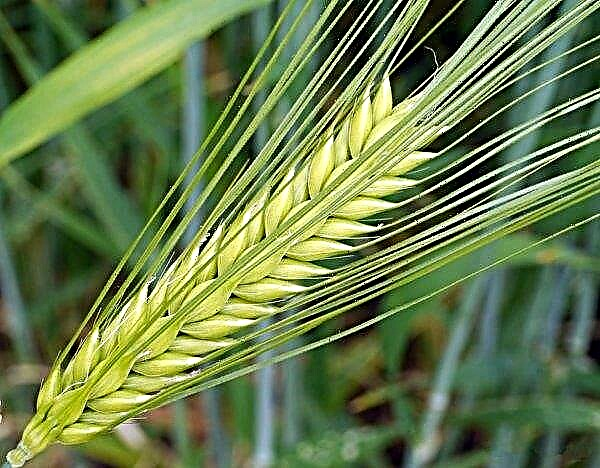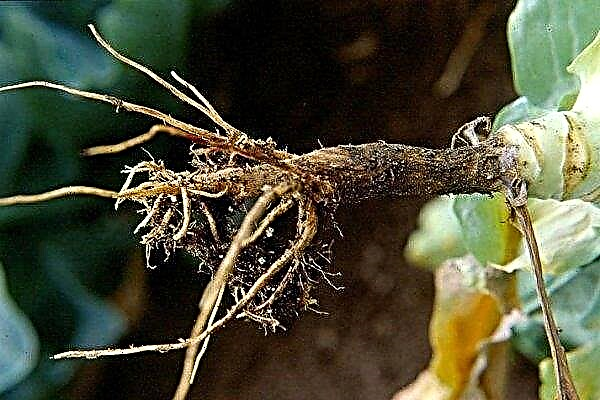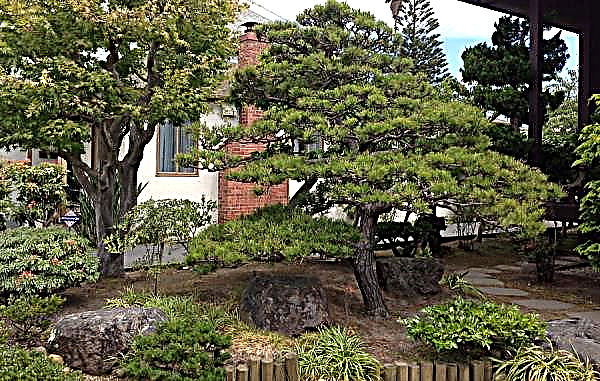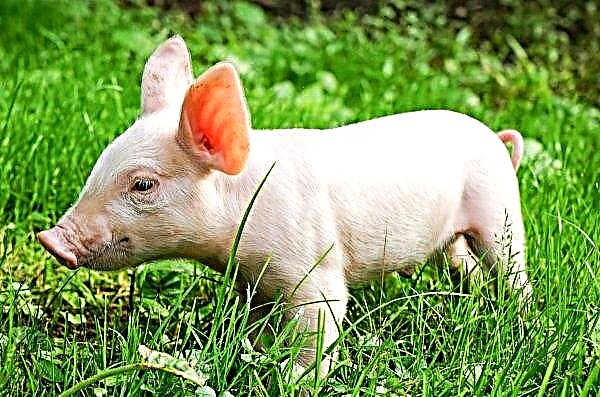Sowing carrot seeds on the site, and then caring for the crops, the summer resident expects that after a while he will receive a plentiful crop of these root crops. But such expectations are not always justified: despite the efforts made, the crops are poorly raised and are not gaining strength. In the article, we consider the possible causes of the slow growth of culture and what can be done in such a situation.
The main causes of poor growth of carrots in the garden
Consider several main reasons, because of which you can not wait for the active growth of the specified root crop.
Did you know? Carrots can replace toothbrushing accessories - toothpaste and brush. If you regularly chew this root crop, then the gums are naturally massaged, and the tooth enamel is cleaned, which serves as a prevention of periodontal disease and caries.
Poor care
One of the reasons for the poor development of root crops may be insufficient crop care. If the bed is overgrown with weeds, it is rarely watered, and the plants are completely denied fertilizing, you should not expect a good harvest. Only compliance with certain rules of agricultural technology will contribute to a better growth of culture.

Adverse weather
Carrots are crops with good cold resistance, so its seeds are able to germinate even at + 3 ° C. But the most optimal temperature for its growth is considered indicators + 18 ... + 24 ° С. That is why, if there is hot and dry weather (from + 30 ° C and above), the culture slows down sharply in growth and development.
Although the summer resident is not able to influence such weather conditions, it is in his power to create the necessary microclimate for the plant on the site. To do this, in the hot period in the evening hours, it is necessary to cool the soil, pouring it by gravity from the hose. This will help the soil cool slightly to a depth of about 2 cm, which will slightly reduce the air temperature above the bed.
Incorrect landing pattern
Carrots can grow poorly due to non-compliance with the rules of sowing. Inexperienced gardeners can either close the seeds to excessive depth or distribute them by surface sowing. Both options are not suitable, because in the first case the small sprouts do not have enough strength to germinate through dense soil layers, and in the second - the seeds can inflate the wind or wash them in streams the rain.
 A guarantee of uniform seedlings of carrots will be their seeding to the same depth.
A guarantee of uniform seedlings of carrots will be their seeding to the same depth.
In order to avoid these problems, it is necessary to observe the correct planting of seed material:
- on dense clay soils, seeds are laid to a depth of 1 cm (taking into account a humid climate);
- on loose and sandy lands, seeds can be buried up to 4–5 cm (with obligatory generous watering).
Invalid crop rotation
It would be a mistake to assume that after harvesting abundant crops in one plot in the current season, the same result should be expected for next year. Experienced gardeners do not advise sowing the crop in the same place for several seasons, since this threatens the depletion of the land.
An optimal break in such a landing would be an interval of 2-3 years. Carrots will grow poorly even after unsuitable predecessors for it - parsley and lettuce (due to common pests).

- The best precursors for these root crops are:
- Tomatoes
- cucumbers
- potatoes;
- cabbage;
- bow;
- garlic;
- dill.
Climate mismatch
It is important to organize the right microclimate for the crop on the site, because it does not grow at too high air temperatures, as well as at high or low humidity. These indicators should be moderate.
In order to provide the shoots with an acceptable microclimate, the following measures are needed:
- after moistening the soil, it is recommended to cover the plantings with film material - this measure will help in creating the greenhouse effect, and also will keep the shoots from the cold;
- lay the film on the arcs, leaving a gap of 12 cm between the soil and the covering material;
- the edges of the film are well fixed so that a strong spring wind could not tear it off;
- it is important to ensure that when the seedlings appear, the bed does not remain covered, otherwise the sprouts will stretch, weaken, or may die.

Excess or lack of light
The culture in question is very demanding on sufficient illumination - it does not tolerate even short-term shading. Accordingly, planting in the vicinity of carrots (on the south side of the bed) tall plants (corn, sunflowers) that block sunlight, can slow down the development of these root crops.
Wrong watering
As for irrigation, their incorrect schedule can also slow down crop growth. The middle ground is important for carrots: a sufficient amount of moisture (especially in the hot season) contributes to good growth, and its overabundance will lead to the opposite result.
Did you know? In carrots, the active formation of root crops begins only after the leaf mass has almost completed its growth.
Poor planting material
Sometimes carrots do not grow well or do not germinate at all due to poor seed quality or missed germination time. Therefore, when buying seed, you must carefully study the recommendations on the packaging and check the expiration date of the contents.

Here are some nuances that testify to the quality of planting material and affect its germination:
- fresh seeds will have a characteristic carrot smell;
- medium sized root crops germinate faster than long-fruit species;
- varieties with small fruits can sprout for a very long time;
- early ripening varieties, although they germinate faster, are not suitable for winter storage.
Seeding density too high
Excessively thickened crops can be another reason why carrots grow poorly. If you do not thin out the planting, the ripening root crops will begin to force each other out of the ground. And the fruits can become deformed (with a sinuous shape).

It is very important to adhere to the following rules for planting and caring for crops:
- The width of the beds should not exceed 1.5 m.
- Between the rows, a distance of 25 cm must be observed.
- It is necessary to break seedlings in order to avoid their high density: before the thinning procedure, the garden is first watered (otherwise you can touch the neighboring sprouts), and then the desired sprout is pulled up.
- For the first time, you need to pull through crops when two true leaves appear.
- After 2-3 weeks, the breakthrough must be repeated, leaving a distance of 5-6 cm between the shoots.
Features and rules for carrot care
Carrots are demanding on moisture, fertility and friability of the soil, as well as on the presence of weeds.
When watering, it is important to consider the stages of crop growth:
- In the vegetative phase of growth, plants need more moisture - they are moistened 3 times in 7 days (in the evening), pouring 4 liters of water per 1 m².
- With the active stage of the formation of root crops, watering is reduced (otherwise it threatens with cracking of the fruit) - up to 1 time per week (8-10 liters per 1 m²).
- At the final phase of the formation of the fruit, irrigation and their number are reduced (up to 1 time in 2 weeks), and then completely stopped until the harvest.

Watering carrots is combined with loosening the soil: after each moistening, the soil between the rows is loosened 5-6 cm in depth. This procedure allows the earth to breathe and improves its structure, which contributes to good fruit growth. Also, weeds that consume nutrients that are intended for root crops are easily removed.
It is very important to feed carrots on time using special fertilizer complexes - three procedures will be required throughout the growing season:
- the first is carried out a month after germination;
- the second - 14 days after the previous one;
- the third - in early August.
Mulching carrots is considered the most effective procedure for the growth of root crops:
- the fruits grow large and juicy;
- weeds do not sprout through thick cover;
- humidity is maintained.
Important! To reduce the impact of pests on growing carrots, beds with plantings must be mulched - this makes it difficult for parasites to penetrate root crops.
The following materials can serve as a protective layer (laid out on a bed with a layer of up to 5–7 cm):
- mowed grass;
- straw;
- wood shavings;
- sawdust.
Ways to increase the growth rate of carrots
To accelerate the growth of carrots, as well as to obtain a rich and high-quality crop, it is recommended to fertilize the culture with folk and store-bought fertilizers.

Folk fertilizers
Folk dressing plants fertilize immediately after the appearance of the first seedlings.
Among them are:
- Iodine. In 10 l of water, dilute 20 drops of the substance and spill this solution between the rows. This will accelerate the growth of root crops, improve their taste and give juiciness, and also protect plants from pests and diseases.
- Wood ash. The powder is scattered over the ridges (1 glass per 1 m²). You can prepare an ash solution: 10 l of water + 100 g of ash, insist for half a day and pour root crops under the root. Feeding will saturate plants with magnesium, sodium, potassium and other substances, which will help the active growth of greenery and prevent the appearance of parasites.
- Yeast (fresh). A solution is being prepared - 2.5 liters of water + 0.5 kg of yeast + 0.5 cups of ash. It must be added to the water (1:10) and feed the plants - this will provide them with nitrogen, phosphorus, etc., improve the quality of the fruit and maintain the microflora of the earth in a healthy state.
- Bird droppings. It is necessary to prepare an aqueous solution (10 parts of water + 1 part of litter) and spill aisles between them. This top dressing will saturate the earth with nitrogen, potassium, phosphorus, zinc and other elements.
- Rotted manure. In 10 parts of water, dilute 1 part of manure and pour it between the rows. Such top dressing contains nitrogen and other substances.
- Nettle infusion. Fill a bucket (10 l) with 2/3 of the chopped nettles, add 1 cup of ash and pour water. Cover and place in a warm place. Stir the solution regularly until it ferments (5-14 days). Dilute 100 ml of infusion in 10 l of water and water the planting under the root. Such a tool will supply carrots with magnesium, iron, potassium and other elements.

Store fertilizers
The growth of carrots is enhanced after the use of store stimulants, which serve as an excellent addition to folk fertilizers.
Among them:
- "Kemira Universal";
- potassium chloride;
- "Fall";
- ammonium nitrate;
- superphosphate;
- "Mortar".
All chemicals for fertilizing the culture must be used strictly according to the instructions.
In order for nothing to interfere with the growth of planted carrots, as well as to obtain a plentiful harvest, it is necessary to avoid situations that can inhibit the growth and development of the crop. In addition, it is important to provide root crops with acceptable care, including top dressing prepared on their own and purchased in the store.












